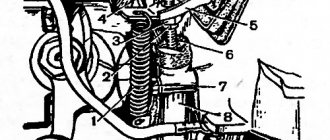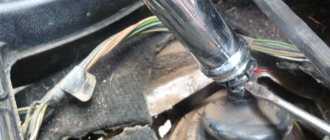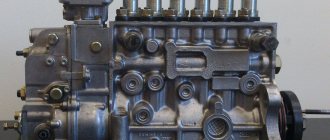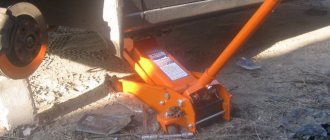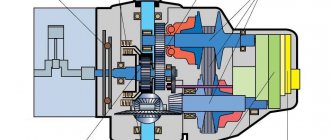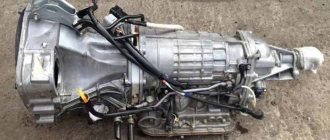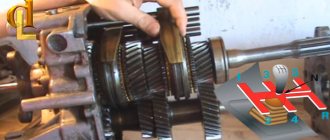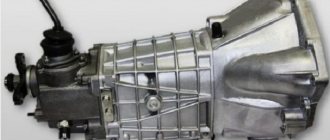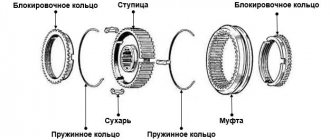The gearbox is one of the most important components of any car, the breakdown of which often leads to the impossibility of further operation of the car. This is a complex unit, regardless of what type of transmission is installed on your car - manual, torque converter, CVT or robot. This means that it should be given increased attention during the operation of the vehicle. We have counted 10 signs indicating a transmission breakdown, if detected, you need to immediately go to a service center =”aligncenter” width=”790″ height=”500″[/img]
Transmission does not start
There are still a lot of cars with manual transmission in Russia. It is reliable and relatively simple, but sooner or later it also breaks. One of the most common malfunctions is the inability to engage the gear. The breakdown looks like this: you get into the car and try to put the car into gear by squeezing the clutch, but the lever seems to rest and does not go into the groove completely. There may be several reasons for this behavior of the transmission. For example, this happens when the oil fluidity is low (often happens in winter), the oil level in the sump drops or the adjustment of the link or cable is incorrect (also typical in winter), or when the clutch breaks down. In any of the above cases, you have serious problems.
[su_divider top=»no» style=»double» divider_color=»#238516" size=»6" margin=»5"]
Current Auto News
[su_cu[su_custom_gallery source=»posts: recent» limit=»3" link=»post» target=»blank» width=»190" height=»190" title=»always»]p>[su_divider [su_divider top= "no" style="double" divider_color="#238516" size="6" margin="5"]burnt groin
Take a sniff. You may smell burning oil and feel heat coming from the gearbox (this is especially noticeable with a longitudinal engine, when the gearbox is directly under the gear selector). A burning smell indicates that your transmission is overheating due to excessive load or a critical drop in the oil level in the unit. Don't forget that oil not only reduces friction losses, but also removes excess heat from the gears. Be that as it may, this malfunction indicates the need for an urgent inspection of the level and quality of the oil, as well as its subsequent topping up or replacement. A low level of lubrication quickly damages the bearings and gears of the gearbox, after which it becomes beyond repair.
What causes node failure
As a rule, gearbox malfunctions occur in the following cases:
- improper operation of the vehicle (poor quality oil, abrupt shifting of the lever, aggressive driving);
- normal wear and tear;
- poor-quality repairs (including the use of non-original components);
- mechanical damage.
All this can lead to malfunctions of the manual transmission.
Noise in neutral
Start the engine and listen. You may notice a strange noise that changes in character when you depress the clutch. Did you notice? The noise may come from excessively worn input shaft bearings. This may also indicate a low oil level or the wrong type, or severe wear on the release bearing. A malfunction of the latter can be detected by pressing the clutch pedal all the way. When the bearing is worn out, you will hear a strong rustling or humming sound. When you release the pedal, the noise becomes muted again.
Pressed pedal
Drivers are often too lazy to move their left foot from the clutch pedal to the dedicated area and keep it on the pedal constantly. As a result, a slightly depressed pedal transmits force through the lever to the fork and the clutch opens slightly. The discs begin to slip when moving and heat up.
Elevated temperatures in the assembly lead to damage to the clutch discs and, as a result, to their failure.
In addition, great harm is done to the unit if the driver keeps the pedal depressed for a long time at stops in front of traffic lights or in traffic jams. In this case, the discs also slip. However, the release bearing wears out more. Under load, it will soon begin to make extraneous noise and will require replacement.
Question answer
Why can't you press the clutch for a long time on a manual transmission?
Knocks out the transmission
Another unpleasant malfunction occurs when the gear selection lever spontaneously begins to jump to “neutral” while driving. As a rule, when the load changes - sudden acceleration or engine braking. This is, at a minimum, unsafe: at the most inopportune moment, you simply lose traction. A driver with such a breakdown has to manually hold the lever in the desired position by removing his hand from the steering wheel. There are also several reasons for the malfunction. The easiest case is destruction or severe wear of the power unit supports. It will be much more difficult and expensive to eliminate damage associated with severe wear of synchronizer teeth and gears. In this case, you will have to dismantle and disassemble the box. Also, gears can be knocked out due to a faulty adjustment of the gear selection mechanism.
Breakage of the clutch basket and wear of the pressure plate
To select gears in a manual transmission vehicle, the driver must disengage the engine and transmission using the clutch. When you press the pedal, a special bearing presses on the elastic petals of the clutch basket, resulting in mechanical separation of the engine and transmission. When the clutch disc is closed, torque is constantly transmitted to the input shaft of the gearbox - it spins idle in the gearbox housing. When the petals wear critically, they break off and do not allow the pressure disk to open. The pressure plate clutches also wear out and begin to slip over time, preventing all the torque from being transferred to the wheels of the car. The car stops driving normally, and the engine speed increases when driving at a relatively low speed. Do not forget that clutch parts during normal operation require periodic replacement on average every 100–160 thousand km.
Features of the mechanism
Before discussing the signs of a faulty transmission, you should understand how this unit functions in general. The purpose of the gearbox is to change torque and transmit it from the power unit to the wheels. With the help of a gearbox, these elements can be separated for an unlimited period of time.
In the case of a mechanical transmission, the torque changes gradually (the role of the stage is played by two interacting gears). Moreover, each stage has its own gear ratio. When the driver changes the position of the lever, the gears move along the shafts and then engage with each other. This is what makes it possible to change the operating modes of the vehicle. Malfunctions of the manual transmission lead to the fact that the car becomes unsuitable for use, or its use will be difficult.
Oil stains
Oil leaks on the gearbox housing or under the bottom of the car require an immediate solution to the problem. Oil can ooze through damaged gear selector rod seals, wheel drive boots, or due to mechanical damage to the unit housing. If a manual transmission loses oil, it overheats and quickly fails, and the automatic transmission stops working altogether. It is difficult to confuse torque converter fluid with other oils used in a car - it has a reddish tint, a pungent odor and a sweetish taste. Unlike the engine, the transmission should not lose oil over time - it does not burn out and does not go anywhere if the unit is in good condition. Checking the oil level is sometimes difficult - there is usually no special dipstick for this; control and addition of fluid is carried out through the filler plug on the housing.
Manual transmission: causes of major malfunctions and ways to eliminate them
Let's study in more detail the main types of malfunctions of both the box itself and the transmission mechanism, as well as providing an ambulance to the car in these cases.
Noise when the shift lever is in the neutral position of the gear selector. The reason for its appearance is most often due to increased wear of the bearings located in the drive shaft of the vehicle, as well as due to a critically low oil level in the gearbox itself. Also, the oil in the transmission may already be of too low a quality level.
This manifestation can be eliminated by checking the oil level and then replacing the worn bearing. If the transmission oil really hasn’t been changed for a long time, you should drain the old one, then replace it with a new one that will match the car. It is recommended to check old oil for the presence of metallic foreign particles and water, which is unacceptable.
If extraneous noise is heard when switching gears, then this may also be due to one of the reasons listed above, or deformation and increased wear of the locking element, as well as insufficient stability of the threaded connections, malfunction of the synchronizers and incomplete disengagement of the clutch.
Elimination of extraneous noise when gears are engaged:
- You should first check that the clutch is in full working order;
- If the synchronizers are faulty, measure the gap between the gears and the blocking ring located here, and also check the gears for damage;
Measuring the gap between gear and ring
When noise is heard during operation of the gearbox, the cause may be high wear of gears, synchronizer couplings, bearings, as well as insufficient oil level in the transmission.
Elimination of noise can occur when adding oil if its level is below critical. This can be detected by the presence of traces of oil leakage from the transmission, and as a preventive measure the oil in a car of any modification should be changed every 10,000 km. It is also necessary to check the condition of the couplings for worn synchronizers and, if necessary, replace them.
This is what a worn gear with synchronizer looks like
If gear shifting is difficult, the drive cable may be loose or damaged, the clutch may not be completely disengaged, or the gear shift rod may be damaged or severely worn.
For better gear shifting in a manual transmission, you should first check whether the clutch is completely disengaged, check the oil level and its quality (if it is unsuitable for further use, replace it with a new one), and also check whether the gears are jamming and carry out a thorough inspection for damage in the system gear shift levers.
Don't forget to check the oil level
The gear shift lever is difficult to change position; you have to make some effort to change gears. The reason here is primarily the insufficient oil level in the transmission, because it is largely responsible for the smoothness of all movements associated with the transmission.
To eliminate this malfunction, you should check the oil level in the transmission and, if necessary, add it to the specified level.
In the case when the gears switch spontaneously, it is possible that the strength of the threaded connection in the fastening of the box itself has decreased, the drive cable has become stuck, or the wear of the gears has increased excessively, the wear of the synchronizer couplings, as well as the splined connections, rod or gear shift fork has reached the limit.
Cable-actuated gear selector
To eliminate this malfunction, it is necessary to clean the distance between the engine housing and the clutch lever located here from dirt, carefully inspect the threaded connections of the transmission, tighten them if necessary, and also, if the synchronizers or splined connections are excessively worn, completely replace them.
When oil begins to leak in the gearbox mechanism, it is visible even to the naked eye. The cause of leakage may be insufficient connection of the transmission itself or worn out seals. If necessary, the oil seals must be replaced, and the threaded connections must be checked and tightened.
The recommendations listed above for troubleshooting both the gearbox itself and the transmission mechanism do not exclude, but rather oblige the owner to show his car to a specialist and carry out the necessary repair work in a workshop.
Malfunctions of any of the systems or individual components can occur in any machine. However, to prevent their occurrence, you should follow simple but quite effective rules regarding the operation of the car. Their simplicity does not mean ineffectiveness, because the rule that any disease is easier and faster to prevent than to treat later applies here.
Regarding the car, we can say that it is easier and also simpler to carry out a preventive inspection than to carry out expensive repairs later.
So, here are the basic tips for preventing major car malfunctions.
The “power unit fault” icon is on
If your car has an automatic transmission, its malfunction may be indicated by a lit “power unit malfunction” icon. This light comes on for many reasons, including the fault of the transmission. You can diagnose a breakdown yourself only if you have a reading device connected to the “brains” of the car through a special connector. Non-standard on-board computers and specialized applications for smartphones can also do this.
Sharp sounds and jerks
The grinding noise also indicates serious problems with the manual transmission. On the “mechanics”, this indicates, in particular, problems with synchronizers and gears. Only a qualified mechanic will determine the exact cause of the unpleasant sounds. A breakdown of the automatic transmission leads to strong shocks when shifting. The smoothness of its operation is lost. This is a sure sign that it's time to go for repairs.
[su_divider top=»[su_divider top=»no» style=»double» divider_color=»#238516" size=»6" margin=»5"]line Autonews
[su_custom_gallery source[su_custom_gallery source=”taxonomy: post_tag/1085,1083,928" limit=”8" link=”post” target=”blank” width=”190" height=”190" title=”always”]” no» style=»d[su_divider top=»no» style=»double» divider_color=»#238516" size=»6" margin=»5"]manual transmission performance
An article about typical manual transmission faults and how to eliminate them. At the end of the article there is a video about mechanical failures.
When it comes to manual transmission - a mechanical transmission option, you can fix most of the problems yourself
. Experiencing significant loads during operation, a manual transmission is subject to various types of malfunctions, but this happens much less frequently than problems arise with automatic transmissions, CVTs and other gearboxes. Let's figure out what defects can arise and how you can deal with them.
Howling and humming
A worn-out manual transmission manifests itself with all sorts of extraneous sounds, which manifest themselves in the form of a characteristic howl, clicking or hum. These sounds come from collapsing bearings and heavily worn friction pairs. In this case, the nature of the sounds changes depending on the selected gear, engine speed and driving mode. It is dangerous to ignore such noises. They manifest themselves especially strongly when the oil level is insufficient or it is contaminated. Transmission noise can indirectly determine the mileage of a car. However, some gearboxes (for example, domestically developed ones) are noisy even from the factory due to weak design and extremely low workmanship.
Complete inoperability
Sometimes a manual transmission stops functioning completely. For example, due to mechanical destruction of gears or bearings, damage to the housing or loss of pushers, which does not allow two gears to be engaged at once. “Automatic machines” often simply lock the selector in the “Parking” or Drive positions. This happens both due to mechanical breakdowns and problems in electrical circuits. In any case, this does not lead to anything good and can result in lengthy, expensive repairs, or even replacement of the unit with a new one.
